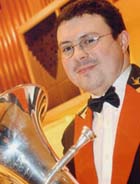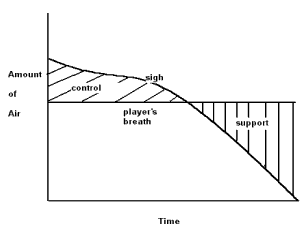Euphonium Masterclass with David Thornton - No1. Back to Basics
13-Jul-2004Black Dyke's David Thornton starts his new series of masterclasses on the art of euphonium playing. It all starts with Back to Basics.
 One of the best parts about playing for a band with a busy concert schedule like that of Black Dyke, is that whilst on our travels I get to meet and talk to fellow euphonium players from all over the world. These players are of a wide variety of standards, some seriously committed to their playing - some take a more casual interest, but most players always ask similar questions: 'How can I improve my playing? Have you any tips for when I practice? How can I become a better band player? How can I…….', and so on. Now of course it would be impossible for anyone to answer such general questions without knowing more specifics about the individual and their playing, but I always offer one piece of advice that I think we all need reminding of, every now and again.
One of the best parts about playing for a band with a busy concert schedule like that of Black Dyke, is that whilst on our travels I get to meet and talk to fellow euphonium players from all over the world. These players are of a wide variety of standards, some seriously committed to their playing - some take a more casual interest, but most players always ask similar questions: 'How can I improve my playing? Have you any tips for when I practice? How can I become a better band player? How can I…….', and so on. Now of course it would be impossible for anyone to answer such general questions without knowing more specifics about the individual and their playing, but I always offer one piece of advice that I think we all need reminding of, every now and again.
Try to remember that the root of most inaccuracy in our playing is at a fundamental level - therefore if we try to practice the 'basics' on a regular basis then we would all be more accurate, more consistent and in the end, better players.
Have a think about the last time you went to see a top class brass soloist in a concert. Afterwards, did you hear the following phrases:
'Didn't they make it look easy?'
'Didn't they make it sound so effortless?'
'Not a nerve in sight!'
'I'm not sure I heard one mistake.'
'So much control!'
Well, there are reasons for these statements being true that go beyond the player being a talented performer and have a lot to do with 'doing the easy things very well'.
Many different players will have several different ways of looking at this subject - because it's one of those areas where what works for one doesn't automatically work for all. In fact, in some rare (and lucky!) cases these skills are natural 'gifts' that a player doesn't really have to think about. But for most of us, we have to continually work at them as part of our regular practice. I've divided the basic techniques into six categories, just as I do during my own practice:
- Breathing
- Flexibility
- Tongue exercises
- Finger exercises
- Reading music
- Aural skills
This article is going to be concerned with the first four from the list above, though we must not forget that being a good technician is almost useless without the ability to read and listen competently,
Almost like the primary colours - I think the more advanced skills, are made up of the above categories. For instance, high register is a mix of a strong and efficient breathing technique, alongside a strong and flexible embouchure. In order to effectively play a double or triple tonguing passage we use a clear articulation, co-ordinated with rhythmic fingers and supported air flow. This is a rather simplistic approach, and players are likely to encounter other pitfalls on the way to such difficult aspects of playing, but surely with these basics in place, we stand a far greater chance.
Breathing
There are so many schools of thought and methods concerning all of these subjects, I can only put forward my approach and the approach I suggest to my students. Breathing is perhaps the subject that seems to get the most complicated - people like to use big medical and anatomical words, describing muscle groups and the way the diaphragm works. This is definitely important on a certain level, but how many of us hear those phrases and truly understands them? I'm not sure I've completely understood everything I've ever heard on the subject. The simplest 'medical' description I have ever come across is below:
Breathing, or ventilation, is the movement of air into and out of the respiratory system. During inspiration, the diaphragm and external intercostal muscles contract, causing the rib cage to expand and the volume of the thoracic cavity to increase. Air then rushes in to equalize the pressure. During expiration, the lungs recoil as the diaphragm and intercostal muscles relax, pushing air out of the lungs.
© 1997 Anatomical Chart Co., Skokie, Illinois
But before we all try to become physicians of some nature, let's remember what we learnt as beginners and go from there. I always start my warm-up with some long low notes, reminding myself about the following points concerning the breath in:
- Stay relaxed during the breath intake (with particular regard to the shoulders and throat).
- Listen to the sound of the breath, no loud gasping (sure sign of throat tension), but a quiet, low-pitched intake.
- For low brass players specifically (because of the larger mouthpiece) - make sure the corners of the mouth open sufficiently to let the air in freely, no sipping noise as the breath slides past the mouthpiece and the lips.
- Remember the areas that we are aiming to fill with air - easily described as low, medium and high. Feel the air fill up like a bottle fills with water - from the bottom up, the stomach region expands, then we feel the back expand and finally spreading to the upper chest.
And that's just the breath in, what about the exhalation:
- Forgetting the instrument is there, try to imagine the column of air traveling away from you in a direct line across the room. This imaginary line doesn't dip or rise, nor does it get faster or slower. This note should be well supported, have a consistent quality of tone and remain the same dynamic.
- Stay relaxed throughout the exhalation (with particular regard to the shoulders and throat).
- Try not to screw up the face, wrinkle the forehead or squint as this can cause unwanted tension and affect the timing of the production.
- I went to a masterclass by German tubist Markus Theinert earlier this year and he used an ingenious graph that shows the difference between a usual breath out (a sigh) and a wind players breath, also showing which areas need support and control:

A sigh involves a quick exhalation followed by a swift decrease in the amount of air leaving the mouth, where as we as wind players want a steady release. So at the start we control the air flow and then as time passes we have to support to maintain it.
So, without going into specific exercises - we all have our own breathing studies - these are the things I try to think about from the very start of any practice session.
Flexibility
Again, without getting into medical explanations, I find easy, slow and simple flexibility exercises to 'loosen' the lips. Still think about good breathing and supported air-flow, creating as smooth a line as possible.
Progress from slow flexibilities to faster ones if you wish, but during a warm-up period never go too high initially (the standard of the player would dictate this). Remember we are aiming to do simple things very well, don't allow yourself to miss or 'fluff' notes - go back and repeat that exercise - over a period of time those mistakes and the need to repeat things should disappear. During my routine I tend to place different flexibility exercises sporadically throughout a practice session - with the idea of simple ones to start and then keep the more taxing exercises for well into a session.
Tongue Exercises
Exercises in this area cover two aspects of playing, production and the speed of articulation.
I find production to be a bit 'fuzzy' round the edges when starting my first practice session of the day - this is because the air, tongue, fingers and any other tiny muscle movements aren't quite co-ordinated. I use a few simple scalic patterns, played at different dynamics and with different types of articulation, to help push this into place. The ability to listen to yourself effectively is crucial throughout so many of these exercises - listen for the production 'fuzz' disappearing as you go through your exercises. Some days this will take longer than others.
Always use a metronome for exercises that work towards improving the single tonguing speed - rhythm and control are essential here. More often than not, a player that suffers from a slow single tongue, will simply be using too much tongue. "Less tongue and more tone", is a phrase I seem to use quite often and remember that a good breath and well supported air-flow will help 'push' the tongue along.
Finger Exercises
In a way, the same principles stated above for the 'tonguing speed' exercises also apply to working on finger exercises. Always use a metronome to maintain rhythm and control, and keep the hand relaxed. I imagine the hand to be in a position that is as if the player is holding a tennis ball, not too 'claw' like and not with the fingers too flat. The length of the player's fingers will dictate this to a certain amount, but ideally the contact point between the top of the valves and fingers is not the finger tips (claw like), nor half way down the finger (fingers too flat), but near to the first joint - which produces a relaxed natural position for the hand. Try not to be too eager to play everything at fast tempos - slow, even and controlled practice on these type of exercises is often more beneficial than rushing through them - only gain speed with control.
Throughout the article I have deliberately stayed away from listing specific exercises - this is because we all know that players the world over, will be using many different method books and following a variety of teaching techniques. I have used a variety of books for my own practice and for teaching: Arban's Cornet Method, Charles Collin's Flexibilities, Allen Vizzutti's Trumpet Method (which is current flavour of the month!) and a few more. Instead, I have tried to talk about the intent and thought behind putting exercises into practice - which brings me back to where I started. We can all be more consistent and technically more capable players by practicing the 'easy' things - which of course in the end turn out to be not that easy at all.















